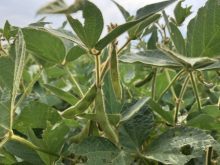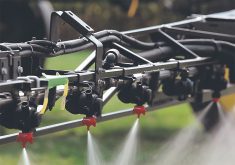Crop planning is not nearly as pleasant this winter as it was last year.
Commodity prices have fallen 20 to 35 percent and input prices have re-mained the same, which means margins are going to be tighter.
It might be a good time for producers to re-evaluate and prioritize their inputs, but the first step is to take a look at yields.
Yield comes from a seed, water, nutrients, sunlight and carbon dioxide.
To break it down further, the basic factors that increase yield include nutrients, water management, sunlight and variety selection.
Read Also

Lower nitrogen rates in dry beans could pay off for farmers
Manitoba research is testing whether reduced nitrogen fertilizer in dry beans can maintain yields while cutting costs and lowering greenhouse gas emissions.
Farmers have some control of three of these factors, but sunlight is out of their power unless they grow crops in a greenhouse.
For nutrients, we rely on the re-serves in our soil that we can manage, as well as augmenting them with applications. We can also manage nutrients using the 4Rs: right time, right product, right rate and right place.
Water management is limited to what Mother Nature provides unless farmers have access to irrigation.
Great strides have been made in Western Canada over the last 30 years to manage water resources. Most farmland now uses a form of conservation tillage to conserve moisture.
So, other than irrigation and nutrient application, a farmer’s maximum yield is set when he leaves the field after seeding.
Every other input he uses on his crop is targeted at maintaining yield rather than improving it.
Significant improvement has been made in developing hybrids and cultivars that increase yield potential. All of today’s hybrids-cultivars offer an excellent yield potential as compared to even 10 years ago.
Other traits such as standability and insect and disease resistance have also greatly improved.
This year, farmers should take a close look at what characteristics or traits they want other than yield. Prioritizing these characteristics will allow them to select the hybrid-cultivar that will best suit their needs. They shouldn’t be afraid to talk to their neighbours and local seed growers.
Seventeen nutrients are required to grow crops. Three essential nutrients, carbon, hydrogen and oxygen, come from atmospheric carbon dioxide and water, while the other 14 come from the soil and are usually grouped as primary nutrients, secondary nutrients and micronutrients.
The primary nutrients, nitrogen, phosphorus and potassium, are commonly found in blended fertilizers such as 30-17-04 or equivalent grades. These, as well as sulfur, make up most of the nutrients applied in Western Canada.
Work done in the late 1990s by Westco Fertilizers tried to measure the yield response from these nutrients as well as a broad spectrum micronutrient blend.
Researchers applied recommended levels of nitrogen to barley plots in central Alberta and continued to add recommended levels of phosphorus, potassium, sulfur and the micronutrient blend.
More than 82 percent of the yield came from nitrogen alone, followed by an additional 12 percent from nitrogen and phosphorus.
The response from adding potassium and sulfur was less than five percent of the total yield, while adding the micronutrients contributed to one percent of the yield.
These tests were done on a single crop, but I believe we can assume that 80 to 90 percent of yield responses to nutrients will come from nitrogen in average conditions where non-legume crops are continuously cropped and don’t follow a legume crop.
Nitrogen also affects crop quality and maturity and is a key contributor to greenhouse gasses and water pollution.
Nitrogen efficiencies can be optimized and losses minimized by following the 4Rs for nutrient stewardship, which include the right place for nutrient application.
A disturbing trend in recent years has been for large growers to move to a broadcast application of nitrogen. This is being done for efficiencies, but it is well documented that a banded or side banded application of nitrogen in the spring is 35 percent more efficient than spring broadcast.
Urease inhibitors, coated urea and rainfall will reduce this gap, but seldom will they reach the same efficiency as banding.
The other fact about nutrients is that there will be a level at which the additional yield attributed to the application will no longer cover the cost of the additional nutrients. This is called the maximum economic yield.
This application level can be significantly lower when commodity prices are depressed than when prices are high. A calculator is available at http://www.gov.mb.ca/agriculture/crops/soil-fertility/nitrogen-rate-calculator.html.
Phosphate, potash and sulfur should be used at soil test recommended levels. Potash may respond to a low level (15 pounds per acre) placed in the seed row, even when sufficient levels are found in the soil. However, applications of less than 15 lb. have not shown economic re-sponses.
Micronutrients should be used only when they occur in deficient levels from a zero to15 centimetre soil test.
My next column will discuss the inputs that protect yield.















